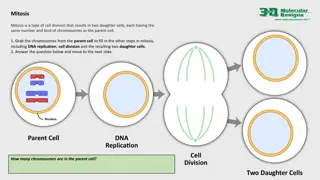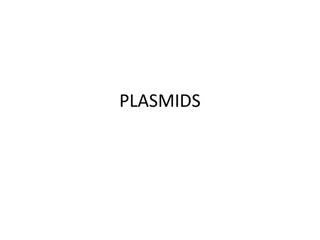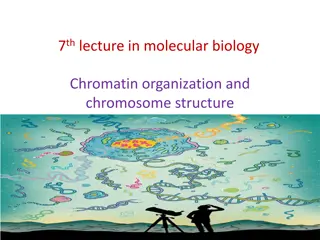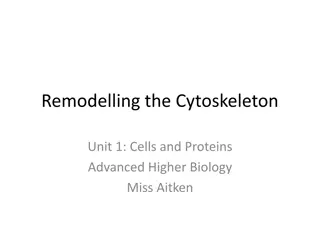❤[PDF]⚡ Zee Zee Does It Anyway!: A Story about down Syndrome and Determination
\"COPY LINK HERE ; https:\/\/uyahsegoro.blogspot.com\/?book=B0BGNN7QZ6\n\n[READ DOWNLOAD] Zee Zee Does It Anyway!: A Story about down Syndrome and Determination | Zee Zee Does It Anyway is a Mom’ Choice Awards® Gold Recipient! PLUSReaders' Favorite gave this book a 5-star review!Have you e
1 views • 2 slides
Chromosomal Alterations and Their Impact on Phenotype
Errors in mitosis or meiosis can result in changes in phenotype, often due to alterations in chromosome structure such as deletion, duplication, inversion, and translocation. Nondisjunction can lead to abnormal chromosome number, resulting in disorders like aneuploidy. Polyploidy, with extra complet
0 views • 9 slides
Genetic Assessment of CNV.J on Chromosome 3q28 - Case Study J
This case study evaluates a copy number variant (CNV) on chromosome 3q28 (190380498_191783134) associated with a loss of genetic material. The assessment includes genomic content analysis, gene involvement categorization, evaluation of established/predicted genes, and detailed scrutiny of the CCDC50
0 views • 16 slides
Understanding Sex-Linked Inheritance: Key Concepts and Examples
Sex-linked inheritance refers to the transmission of genetic traits determined by genes located on the sex chromosomes. This type of inheritance differs from autosomal inheritance due to the unique characteristics of the X and Y chromosomes. In organisms with XX/XY sex determination, genes on the X
1 views • 21 slides
Cell Division Processes: Mitosis and Meiosis Explained
Mitosis and meiosis are two types of cell division processes with distinct outcomes in terms of chromosome numbers. Mitosis results in two daughter cells with the same number of chromosomes as the parent cell, while meiosis produces four gamete cells with half the chromosome number. This explanation
2 views • 5 slides
Lampbrush and Polytene Chromosomes: Structures and Functions
Lampbrush chromosomes, found in growing oocytes of vertebrates, display large loops of DNA during the diplotene stage, with high gene expression levels. Polytene chromosomes, giant interphase chromosomes in insects, contain multiple strands with distinct banding patterns. Chromocenter serves as the
0 views • 14 slides
Understanding Human Chromosomes and Genetics in Health and Disease
Human chromosomes play a crucial role in genetics, ranging from heredity to disease. Cytogenetics studies their structure and behavior, essential for diagnostics like prenatal testing and identifying genetic disorders. The coiling and folding of DNA within chromosomes, along with the mitotic cell cy
0 views • 15 slides
Understanding Structural Chromosomal Aberrations and Their Impact on Genetic Information
Chromosomal aberrations involve significant changes in chromosome structure and number, impacting multiple genes. These mutations can be structural or numerical, resulting in alterations such as deletions, duplications, inversions, and translocations. Deletions, for example, involve missing chromoso
0 views • 28 slides
Understanding Somaclonal Variation in Plants
Somaclonal variation refers to genetic variations in plants produced through tissue culture, leading to changes in chromosome structure, growth rate, and fertility. This variation can be caused by physiological, biochemical, and genetic factors, and is detectable through morphological and cytologica
0 views • 21 slides
Features of an Appropriate Capital Structure and Optimum Capital Structure
While developing a suitable capital structure, the financial manager aims to maximize the long-term market price of equity shares. An appropriate capital structure should focus on maximizing returns to shareholders, minimizing financial insolvency risk, maintaining flexibility, ensuring the company
3 views • 5 slides
Understanding Mutation and Polyploidy in Genetics
Mutation is a sudden hereditary change in an organism's genetic makeup, leading to variations in offspring. This article delves into the history, types, and causes of mutations, featuring significant discoveries by scientists like De Vries and Morgan. It also explores the concept of spontaneous muta
0 views • 50 slides
Understanding Plasmids: DNA Molecules Free of Chromosome
Plasmids are DNA molecules existing free of the chromosome in a cell. They can be circular or linear and carry genes beneficial to the host. Plasmids replicate from unique origins and regulate copy numbers through various mechanisms. Different replication mechanisms, such as theta and RC, are used,
0 views • 31 slides
Understanding Chromatin Organization and Chromosome Structure in Molecular Biology
Chromosomes are the carriers of genetic information in cells, containing genes made of DNA. Chromatin, composed of DNA wrapped around histone proteins, plays a crucial role in organizing genetic material. Humans have 23 pairs of chromosomes, and the Human Genome Project aims to map the human genome.
0 views • 21 slides
Understanding Chromosome Territories in the Nucleus
Chromosome territories refer to specific regions in the nucleus where chromosomes are organized. While chromosomes appear as condensed structures during cell division, they have a different appearance in non-dividing cells like neurons. Scientists have used microscopy to study chromosome organizatio
0 views • 17 slides
Understanding Chromosomes: Key Components, Functions, and Significance
Chromosomes, essential in mitosis and meiosis, are condensed forms of DNA vital for heredity, mutation, and evolution. Learn about their structure, role in inheritance, and impact on species development through historical discoveries. Discover the importance of chromosome sets and genomes in gametic
0 views • 38 slides
Understanding Numerical Chromosome Aberrations in Humans
Numerical chromosome aberrations involve the gain or loss of whole chromosomes, impacting the genome size and potentially leading to genetic mutations. Nondisjunction, where chromosomes fail to separate properly during cell division, can result in aneuploidy - the presence of an extra or missing chr
0 views • 18 slides
Understanding Chromosomal Aberrations and Mutations in Genetics
Chromosomal aberrations and mutations are key events that can alter the genetic structure of organisms. They can lead to numerical abnormalities like aneuploidy and structural abnormalities such as ring chromosomes and chromosome fragments. Understanding these variations in chromosomes is crucial in
0 views • 10 slides
Understanding Human Chromosome Nomenclature and Structure
In humans, each cell typically contains 23 pairs of chromosomes, with 22 autosomes and one pair of sex chromosomes. Chromosomes can be classified based on their structure, centromere position, and banding patterns. The location of the centromere on each chromosome is important for gene mapping and i
0 views • 17 slides
Understanding Cytogenetics: The Study of Chromosomes and Genes
Cytogenetics is the study of chromosome number, structure, function, and behavior in relation to gene inheritance, organization, and expression. It plays a crucial role in detecting genetic abnormalities that can range from vitamin deficiencies to severe conditions like cancer and birth defects. By
0 views • 26 slides
Understanding the Cell Cycle and Mitosis Process
The cell cycle consists of two main periods: Interphase and Mitosis. During Interphase, the cell prepares for division by growing in size and copying chromosomes. Mitosis, the division of the nucleus, results in the formation of two daughter cells with identical chromosome copies. Centrioles and cen
0 views • 26 slides
Understanding Chromosome Aberrations in Genetics
Chromosome aberrations are deviations from the normal set of chromosomes, which can involve changes in chromosome number, gene arrangement, and appearance. These aberrations can be associated with genetic diseases and species differences. They encompass alterations in the number of genes within a ch
0 views • 7 slides
Understanding Ploidy and Chromosome Numbers in Organisms
Ploidy refers to the number of complete sets of chromosomes in a cell, impacting the number of possible alleles. Humans are diploid, with 2 sets of 23 chromosomes each from parents, totaling 46 chromosomes. The haploid number for humans is 23, and the monoploid number is also 23. Variations in ploid
0 views • 8 slides
Understanding Down Syndrome: Causes, Effects, and Characteristics
Down syndrome, also known as Trisomy 21, is a genetic condition caused by the presence of an extra 21st chromosome. Discovered by Dr. John Langdon Down in 1866, this condition affects individuals in various ways, influencing their development and abilities. People with Down syndrome may learn skills
0 views • 10 slides
Understanding X-Linked Inheritance and Diseases
X-linked inheritance involves genes on the X chromosome, leading to unique inheritance patterns and characteristics. X-linked diseases vary in expression between males and females due to differences in chromosome composition. X-linked dominant traits are rare but can have significant impacts on affe
1 views • 21 slides
Understanding Down Syndrome: Types, Characteristics, and Impacts
Down syndrome is a genetic condition caused by an extra chromosome, typically chromosome 21. This leads to physical and cognitive challenges, with individuals exhibiting unique abilities. The syndrome presents with distinctive physical features, such as flattened face, almond-shaped eyes, and poor m
2 views • 14 slides
Cell Division Mechanisms in Prokaryotic and Eukaryotic Cells
Prokaryotic cells divide through binary fission, while eukaryotic cells undergo mitosis with nuclear division and cytokinesis. Prokaryotic cells lack a nucleus and divide by replicating DNA and forming two identical daughter cells. Eukaryotic chromosomes, associated with histone proteins, undergo co
0 views • 56 slides
Investigating Cell Division Mini-Quiz - Learn About Cell Biology
Explore the world of cell division through a mini-quiz covering topics such as the importance of cell division, chromosome structure, mitosis, and more. Test your knowledge and enhance your understanding of cellular processes.
0 views • 41 slides
Understanding Mutations: Types, Causes, and Significance
Explore the world of gene mutations and chromosome mutations, including point mutations, frameshift mutations, and changes in chromosome structure. Learn about the significance of mutations, how they can be inherited or acquired, and their impact on genetic information. Uncover examples of neutral,
0 views • 9 slides
Genetics Common Terminologies Part II Study Material for B.Sc. Botany Hons.
Covering a range of genetic terms from J to Z, this study material provides insights into various concepts including gene components, genome elements, DNA regions, chromosome structure, gene relationships, inheritance patterns, and genetic variability. Designed for B.Sc. Botany Hons. students, it ex
0 views • 15 slides
Understanding DNA Structure and Denaturation Process
DNA is a double helical structure made of 2 antiparallel polynucleotide chains with nucleotide monomers. The structure contains deoxyribose sugar, phosphate groups, and nitrogenous bases (purines and pyrimidines). Hydrogen bonds between base pairs stabilize the structure. Denaturation can occur due
0 views • 16 slides
Protein Secondary Structure Prediction: Insights and Methods
Accurate prediction of protein secondary structure is crucial for understanding tertiary structure, predicting protein function, and classification. This prediction involves identifying key elements like alpha helices, beta sheets, turns, and loops. Various methods such as manual assignment by cryst
0 views • 30 slides
Understanding the Hierarchy of Protein Structure
To understand proteins' final shape and function, one must grasp the primary, secondary, tertiary, and quaternary structure levels. Proteins, composed of amino acids, fold into various shapes crucial for their roles such as signaling, catalysis, and structure. The primary structure represents the am
0 views • 28 slides
Understanding Prokaryotic and Eukaryotic Chromosome Organization
Chromosomes are vital structures in cells, holding genetic material. Prokaryotic cells have a nucleoid containing DNA while eukaryotic cells have DNA enclosed in a nucleus. Proteins like H-NS, HU, FIS, and IHF play crucial roles in maintaining chromosome structure and gene expression. Unlike eukaryo
0 views • 20 slides
Understanding DNA and Genetics: A Comprehensive Overview
Living things store, retrieve, transmit, and respond to information essential for life processes. This encompasses the heritability of genetic traits through DNA and RNA, the discovery of the double helix structure of DNA, and key experiments validating DNA as the heritable molecule. Explore the com
0 views • 30 slides
Understanding Gene Hunting and Disease Genes in Human Genetics
Gene hunting involves finding genes responsible for diseases by statistically linking them with markers on chromosomes. This process relies on the logical structure of chromosomes, genotypes versus phenotypes, recombination phenomena, and specific loci like the ABO locus on Chromosome 9. By analyzin
0 views • 18 slides
Understanding the Chromosome Theory of Sex Determination
The concept of sex differentiation in organisms, the role of gamete size, hermaphroditism vs. dioecious species, and the chromosome theory of inheritance are explored. Discover how the presence of specific chromosomes determines sex in insects and how individual genes on sex chromosomes impact sexua
0 views • 17 slides
Understanding Bacterial Genetics and DNA Structure
Explore the intricate world of bacterial genetics and DNA structure. Genes dictate the characteristics of bacteria, with each gene controlling specific properties. The double-stranded DNA structure, consisting of nucleotides and nitrogen bases, carries vital genetic information. Discover how genes a
0 views • 20 slides
Understanding Nucleic Acids and the Central Dogma of Molecular Biology
In molecular biology, understanding nucleic acids like DNA and RNA is crucial for comprehending the central dogma, which explains the flow of genetic information from DNA to RNA to proteins. Nucleic acids are polymers of nucleotides, composed of pentose sugar, nitrogenous bases, and phosphate groups
0 views • 18 slides
Understanding the Role of Microtubules in Cell Remodeling
The cytoskeleton, a network of fibers made from proteins, plays a crucial role in maintaining cell structure and shape. Microtubules, which are hollow straight rods made from tubulin proteins, control the movement of membrane-bound organelles and cell components. During cell division, microtubules a
0 views • 8 slides
Insights into DNA Replication and Chromosome Structure
DNA replication is a fundamental process vital for the transmission of genetic information. Chromosomes, composed of DNA-protein complexes, store genetic information, and replication involves the synthesis of new DNA molecules. Enzymes play crucial roles in DNA synthesis, and in E. coli cells, repli
0 views • 16 slides
![❤[PDF]⚡ Zee Zee Does It Anyway!: A Story about down Syndrome and Determination](/thumb/20462/pdf-zee-zee-does-it-anyway-a-story-about-down-syndrome-and-determination.jpg)






































